

Its unit of dimension when working with the International System of Units is meters to the fourth power, m4. For the derivation of the moment of inertia formula of a circle, we will consider the circular cross-section with the radius and an axis passing through the centre. We may also deduce from the preceding formula of polar MOI that the. In maths, we can write the polar moment of inertia, i.e. MOMENT OF INERTIA (I) I, for rectangular and circular sections about their NA can be found using following formulae: I for I-sections, Box sections and channel sections can be found using following formulae: Transfer of axis for Moment of Inertia This formula is used to find MI of a T or other sections, whose NA or CG is not located at the.

Polar moment of inertia is a quantity used to predict an object’s ability to resist torsion, in objects ( or segments of objects) with an invariant circular cross section. J will reveal the polar moment of inertia. Now, from equation (1) and (2), we get I < I’ Polar moment of inertia. Design equation Applied factored moment moment capacity of the section OR Required moment strength design strength of the section M M u b n In order to calculate the nominal moment strength Mn, first calculate, , and for I-shaped members including hybrid sections and channels as Lp Lr Mr y p y F E 1.76 L r - a section property. In both cases, it is calculated with a multiple integral over the object in question. The polar MOI of a flat area is defined as the area inertia about in an axis perpendicular to the plane of form and passing through the area’s centre of gravity. The second moment of area is typically denoted with either anįor an axis that lies in the plane or with aįor an axis perpendicular to the plane. For the needs of this example, the distance of the centroid from the base of the shape is also given: y c 19.5. Shape dimensions are: a25, b50, d30 and t9. For a circular tube section, substitution to the above expression gives the following radius of gyration, around any axis:Ĭircle is the shape with minimum radius of gyration, compared to any other section with the same area A.The 2nd moment of area, also known as moment of inertia of plane area, area moment of inertia, or second area moment, is a geometrical property of an area which reflects how its points are distributed with regard to an arbitrary axis. Calculate the moment of inertia of the shape given in the following figure, around a horizontal axis x-x that is passing through centroid. Small radius indicates a more compact cross-section. It describes how far from centroid the area is distributed. The dimensions of radius of gyration are. Typically the more distant fiber is of interest. Where I the moment of inertia of the cross-section around a given axis and A its area. , the moment of inertia of the section around x axis and Y the distance from centroid, of a section fiber, parallel to the same axis.

Radius of gyration R_g of a cross-section is given by the formula: Where, D, is the outer diameter and D_i, is the inner one, equal to: D_i=D-2t. Įxpressed in terms of diamters, the plastic modulus of the circular tube, is given by the formula: The last formula reveals that the plastic section modulus of the circular tube, is equivalent to the difference between the respective plastic moduli of two solid circles: the external one, with radius R and the internal one, with radius R_i. The moment of inertia (second moment of area) of a circular hollow section, around any axis passing through its centroid, is given by the following expression: The total circumferences (inner and outer combined) is then found with the formula: Its circumferences, outer and inner, can be found from the respective circumferences of the outer and inner circles of the tubular section. Where D_i=D-2t the inner, hollow area diameter. In terms of tube diameters, the above formula is equivalent to: Beams - Fixed at Both Ends - Continuous and Point Loads Stress, deflections and supporting loads. Beam Loads - Support Force Calculator Calculate beam load and supporting forces.

Where R_i=R-t the inner, hollow area radius. Area Moment of Inertia - Typical Cross Sections II Area Moment of Inertia, Moment of Inertia for an Area or Second Moment of Area for typical cross section profiles. The area A of a circular hollow cross-section, having radius R, and wall thickness t, can be found with the next formula:


 0 kommentar(er)
0 kommentar(er)
